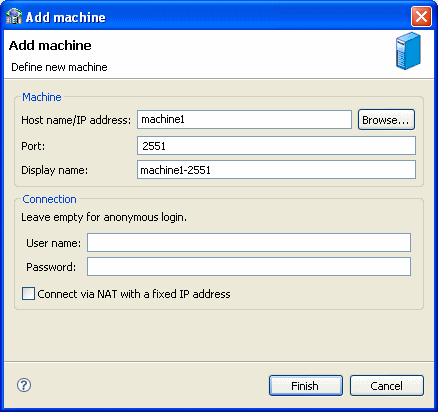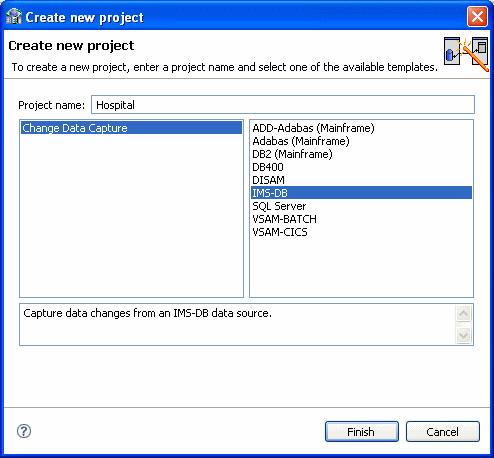4 Configuring an IMS/DB CDC Adapter
This chapter provides an example for creating an OracleAS adapter for IMS/DB. To work with an OracleAS adapter for IMS/DB, you must also configure either a BPEL process or a Mediator process. For information on using BPEL or Mediator, see Creating the Project in JDeveloper Examples.
Creating Outbound Interactions with the OracleAS Adapter for IMS/DB
To work with the OracleAS Adapter for IMS/DB and create outbound interactions you must create an IMS/DB data source, import the metadata from IMS/DB, create a database adapter, then create interactions that are used to access the data.
Adding the IMS/DB Hospital Data Source
To create an IMS/DB data source you must do the following:
Prepare the System
Ensure that the Hospital database is available under IMS/DB on the Mainframe computer.
Set up Machine Access to Oracle Connect
You begin by configuring access to the Mainframe computer with your IMS/DB data. You configure this access with Oracle Connect. Open Oracle connect and follow the directions Setting Up the IBM z/OS Platform in Oracle Studio. Enter the following information in the Add machine dialog box:
-
Host name/IP address: Enter the name or IP address for the Mainframe computer with the Hospital database. This should be installed in the same directory as Oracle Connect.
-
Port: Enter the port number where the daemon is running. The default port is 2551.
-
Display name: You do not need to enter any information in this field (By default, the display name is the host name and the port number).
-
User name: If the computer you are accessing needs an administrator password. If so enter the name o f the computer's administrator.
-
Password: If necessary, enter the computer administrator's password.
-
Connect via NAT with fixed IP address: Select this if the machine uses the NAT (Network Address Translation) firewall protocol, with a fixed configuration, mapping each external IP to one internal IP, regardless of the port specified.
Figure 4-1 shows the Add Machine dialog box with the correct information:
Add an IMS/DB Data Source
After you add the computer configuration to Oracle Studio, you can add your IMS/DB data source to the Configuration view. To add an IMS/DB data source, do the following:
-
Expand the computer you just added and then expand the NAV binding.
-
Right-click the Data sources folder and then select New data source.
-
In the New data source dialog box, type Hospital in the Name field.
-
In the Type field, select IMS-DLI and then click Finish. You do not need to add any additional connection information.
For detailed information on adding the IMS/DB data source, see Configuring the Data Source Driver.
Figure 4-2 shows the Add data source dialog box with the correct information:
Import the Metadata
You now import the metadata from the IMS/DB data into the data source. For information on how to import data, see Importing Metadata for the IMS/DB Data Source.
In this example you should import the metadata for the Hospital database. This database is supplied as an example with Oracle Connect and should be installed when you install Oracle Connect on your Mainframe computer.
You need the following information for the metadata import:
-
In the Get Input Files step, add the files,
hospital.dbd,hospital.cob, andhospital.psb. -
In the Apply Filters step, just click Next.
-
In the Select Tables step, select DOCTOR and PATIENT.
-
In the Match DBD to COBOL screen match the equivalent COBOL table to DBD table then click Next.
-
In the Import Manipulation step, click Next.
-
In the Metadata Model Selection step, select Default value for all tables, then click Next.
-
In the Import Metadata step, select Yes and then click Finish.
Create a Change Data Capture
You now create the change data capture for the tables you imported. When you are finished you can create WSDL and binding (jca) files. See Create the JCA Configuration Files for more information.
These files contain the information needed to create the BPEL and Mediator projects in JDeveloper. For more information on using JDeveloper for the BPEL Process Manger and Mediator, see Creating the Project in JDeveloper Examples.
Before you begin to set up your change data capture make sure that the IMS/DB is set up to handle a change data capture. For information on how this is done, see Configuring the DFSFLGX0 Exit and Setting up Security for the OracleAS CDC Adapter.
The following sections describe how to create a change data capture in Oracle Studio.
Setting up a Change Data Capture
The following procedure describes how to set up your change data capture for this sample. For detailed information on setting up a change data capture for IMS/DB, see Setting up a Change Data Capture in Oracle Studio.
-
Open the Solution perspective in Oracle Studio.
-
In the left pane, click Create new project.
-
Enter the following:
-
Project name: Hospital
-
Type: IMS-DB
Figure 4-3 shows the correct data in the Create new project screen.
-
-
Click Design and then click Next and Finish to use the default values in the screens. If you want to set up your staging area on a UNIX computer, then you must change that setting in the second screen. For information on how to do this, see Create a CDC Project.
-
Click Implement to go to the Implementation guide.
-
For Server Configuration, enter the following information:
-
Machine: Enter the information for the z/OS computer with Oracle Connect installed.
-
Metadata: Enter the following:
-
Select metadata source: Select Copy from existing metadata.
-
Copy from existing metadata source: Find and expand the Hospital data source you created, and then select all of the available columns, and move them to the right side of the Copy Existing Metadata Source screen.
-
Customize Metadata: Just click Next in all of the screens to use the default values.
For more information, see Set up the CDC Server.
-
-
-
For Stream Service Configuration, enter the following information:
-
Machine: Enter the information for the computer you are using as your staging area. This must be a Windows or UNIX machine.
-
Stream Service: Enter the following:
-
In the Staging Area screen, enter a location for the change files on the computer you specified and the Staging Area computer.
-
In the Changed Data Capture Table Selection, select all of the tables.
-
In the remaining screens, click Next to use the default values.
-
-
Access Service Manager: Click Next in all of the screens to use the default values.
For more information, see Set up the Staging Area Server.
-
You must now Deploy the Solution.
Deploy the Solution
To deploy the solution, click Activate Workspaces. Click OK in any screen that opens. If you get a message about a naming collision, you must resolve this first.
For information on deploying a change data capture, see Deploying a Change Data Capture
Create the JCA Configuration Files
You must create both a WSDL and JCA file to set up your connection with JDeveloper. You create the files using Oracle Studio before setting up the BPEL process or Mediator connections.
For information on how to create JCA configuration files, see Creating JCA Configuration Files. To create the files for the Hospital_CDCQueue adapter, do the following:
-
From the Configuration pane in Oracle Studio, expand the binding for the CDC staging area that you created. The name of the binding is the Project name for the CDC solution that you created in Oracle Studio with the suffix
_SA.See Creating JCA Configuration Files for more information.
-
Right-click the
Hospital_CDCQueueadapter and select Generate JCA Configuration Files. -
Save the files to a place you can find when you create the BPEL process or Mediator connection.


